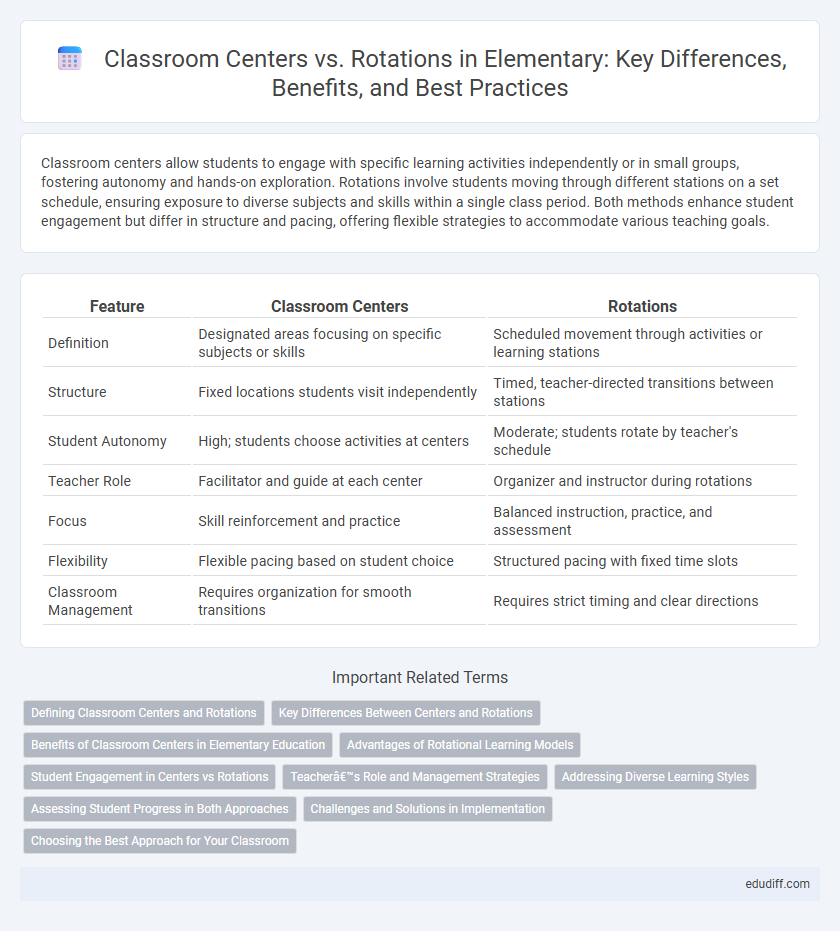Classroom centers allow students to engage with specific learning activities independently or in small groups, fostering autonomy and hands-on exploration. Rotations involve students moving through different stations on a set schedule, ensuring exposure to diverse subjects and skills within a single class period. Both methods enhance student engagement but differ in structure and pacing, offering flexible strategies to accommodate various teaching goals.
Table of Comparison
| Feature | Classroom Centers | Rotations |
|---|---|---|
| Definition | Designated areas focusing on specific subjects or skills | Scheduled movement through activities or learning stations |
| Structure | Fixed locations students visit independently | Timed, teacher-directed transitions between stations |
| Student Autonomy | High; students choose activities at centers | Moderate; students rotate by teacher's schedule |
| Teacher Role | Facilitator and guide at each center | Organizer and instructor during rotations |
| Focus | Skill reinforcement and practice | Balanced instruction, practice, and assessment |
| Flexibility | Flexible pacing based on student choice | Structured pacing with fixed time slots |
| Classroom Management | Requires organization for smooth transitions | Requires strict timing and clear directions |
Defining Classroom Centers and Rotations
Classroom centers are defined as distinct areas in an elementary classroom where students engage in specific activities independently or in small groups, fostering hands-on learning and exploration. Rotations refer to the structured schedule that allows students to move between different centers or activities, ensuring exposure to varied learning experiences throughout the day. This system promotes personalized instruction and maximizes classroom management by organizing student movement and task completion.
Key Differences Between Centers and Rotations
Classroom centers are designated areas where students engage in independent or small group activities focusing on specific skills or subjects, providing flexible, self-paced learning opportunities. Rotations involve scheduled movement of students through various centers or stations, allowing structured exposure to multiple activities within a set timeframe. Key differences include the degree of student autonomy and the structure of movement, with centers promoting choice and rotations ensuring systematic instructional delivery.
Benefits of Classroom Centers in Elementary Education
Classroom centers in elementary education promote hands-on learning by providing students with diverse, engaging activities tailored to individual skill levels. These centers encourage collaboration, enhance social skills, and foster independence, allowing teachers to address varied learning needs simultaneously. Research shows that classroom centers improve student motivation and academic achievement by creating interactive and dynamic learning environments.
Advantages of Rotational Learning Models
Rotational learning models enhance student engagement by allowing personalized instruction tailored to individual needs within classroom centers. These models maximize instructional time through efficient transitions and provide varied learning experiences, fostering deeper understanding and skill development. Data shows students in rotation-based classrooms demonstrate improved collaboration and higher academic achievement compared to traditional static centers.
Student Engagement in Centers vs Rotations
Classroom centers encourage student engagement by offering hands-on activities tailored to diverse learning styles, promoting independence and creativity. Rotations enhance engagement through structured transitions, ensuring students interact with varied tasks and peers, which sustains focus and motivation. Both models support active learning, but centers provide more flexibility, while rotations offer organized pacing and accountability.
Teacher’s Role and Management Strategies
Classroom centers require teachers to design focused activities that encourage independent learning, enabling students to engage in self-guided tasks while the teacher monitors progress and provides targeted support. In rotation models, the teacher actively facilitates small group instruction, tailoring lessons to different skill levels and managing smooth transitions between stations to maximize engagement and instructional time. Effective management strategies include clear expectations, consistent routines, and ongoing assessment to ensure all students remain on task and benefit from personalized guidance.
Addressing Diverse Learning Styles
Classroom centers and rotations both address diverse learning styles by providing varied, hands-on activities tailored to auditory, visual, and kinesthetic learners. Centers allow students to explore content at their own pace through targeted tasks, enhancing engagement and understanding. Rotations facilitate differentiated instruction by cycling students through multiple modalities, ensuring each learning preference is actively supported.
Assessing Student Progress in Both Approaches
Classroom centers allow teachers to observe and assess student progress in small, focused groups, providing real-time feedback based on hands-on activities. Rotations offer systematic opportunities to track individual progress through scheduled transitions, enabling data collection across varied learning modalities. Combining observational insights with student work products from both approaches enhances accurate and ongoing assessment of student development.
Challenges and Solutions in Implementation
Classroom centers often face challenges like managing student behavior and ensuring engagement, which can be mitigated by clear routines and targeted teacher support. Rotations present difficulties in timing and smooth transitions, solvable through precise scheduling and use of timers or signals. Integrating technology tools enhances monitoring and streamlines both centers and rotations for effective elementary classroom implementation.
Choosing the Best Approach for Your Classroom
Classroom centers offer students hands-on learning experiences by dividing the room into subject-specific areas, promoting independence and engagement. Rotations involve students moving through different activities or subjects on a timed schedule, ensuring varied instruction and maintaining high energy. Choosing the best approach depends on class size, curriculum goals, and student learning styles to maximize participation and understanding.
Classroom Centers vs Rotations Infographic

 edudiff.com
edudiff.com